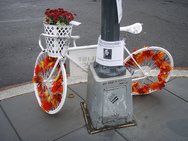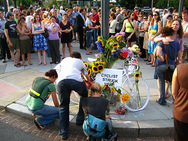Alice’s Blend: The people behind the ghost bike saga
(All the buzz over the ghost bikes at Dupont Circle made me wonder: who are the people caught up in this controversy anyway? I used a recent assignment for a feature writing class I’m enrolled in as an excuse to tackle the question.)
Ruth E. Rowan and Legba Carrefour aren’t the likeliest of pairs.
Rowan, 59, a part-time finance professor at Clark University in Massachusetts, describes herself as a pragmatist. She graduated from MIT’s Sloan School of Business in 1977, and worked in corporate finance for more than 25 years. Though semi-retired now, she remains a member of the Boston Security Analysts Society, a networking organization for financial analysts.
She attends church services regularly, along with her husband, Brian Swanson, at the Unitarian Universalist Church in Northborough, MA, the small suburban town in Eastern Massachusetts where she lives. Brian, a mechanical engineer who has a number of patents to his name—including one for a resuscitation device for use during medical emergencies—served as the church’s vice president for finances.
Phillip Blair, Rowan’s brother-in-law and an information officer for the World Bank, put it this way: “Ruth’s certainly not some wild hippy.”
Legba, in contrast, would likely welcome some variation of such a title. Carrefour, 27, a life-long resident of Washington, DC and a graduate of the University of District of Columbia, has described himself, at times, as an artist, an activist, and an anarchist.
He’s not the sort of person who prefers to hold down a nine-to-five job, though he never seems to be short of a gig. One of Legba’s friends, Jesse Hinson, a bicycle messenger from Washington, ticks off a few of them to me: DJ, comic book retailer, bike mechanic.
Unlike Rowan, who has only a sparse presence online, Legba leaves a heavy footprint in cyberspace. He comments frequently on articles and blogs, sharing fringe but articulate thoughts on topics ranging from political philosophy, to graffiti, to whether the participatory Burning Man Arts Festival is welcoming enough to minorities. While many online commentors hide behind pseudonyms, Legba has no qualms about signing his name to his contributions.
At one point, Legba was kicked out of Virginia Tech and sent to jail for two months—for making anti-racism and anti-rape graffiti. He was arrested in 2000 for laying in the middle of the street during a rally to free Abu-Jamal, a former black panther convicted of killing a police officer. He’s been arrested during IMF protests. “I get really pumped up [by the confrontational stuff],” he once told the Washington Post.
Legba lists Grant Morrison, a comic book illustrator known for non-linear narratives, as somebody he admires. He’s a fan of Playground Anarchism—an informal group of activists who encourage each other to embrace their inner child and savor the “surge of adrenaline that comes from almost getting caught doing/being some form of ‘naughty.’ “
Like his work history, Legba’s appearance is such that many in the button-down city of Washington—brimming with its lobbyists, hill staffers, and bureaucrats—surely dismiss him as a loser and a freak. On his Facebook page, Legba’s profile photo shows him wearing white makeup and what appears to be a black vinyl bra and a dog collar. He has a lip ring. He looks like he’d fit in during a Marilyn Manson concert. And he rides a bicycle.
Indeed, it is bicycles that made this unlikely pair—so many years and states apart—aware of each other’s existence. Legba, who doesn’t own a car, bicycles everywhere just to get around the city. Decades ago, when she was an analyst working in Washington, Ruth did the same.
Ruth use to ride every day from her apartment in Washington Circle, where she lived then, to Capitol Hill, where she worked. “Cyclists were such a rare occurrence back then, especially women, that I remember the police officers use to cheer for me when I was coming up the hill next to the Capitol,” she recalls.
As time went on, she bicycled less frequently, but she passed the habit on to her daughter, Alice Swanson, who also used to ride to work regularly when she was an associate at IREX, a non-profit headquartered on K Street, in Washington in 2008. Alice who graduated from Amherst College in 2007 with a degree in history, loved Washington, according to her mother. “She was so full of life there,” she said.
Her stay in Washington, however, was brief. Alice, then 22, was struck and killed by a man driving a garbage truck while she was bicycling to work on July 8 , 2008. At the time of the collision, which occurred near Dupont Circle at the corner of Connecticut and R Street in broad daylight, Alice, a novice rider, was riding in a bike lane and wearing a helmet. Neither of those facts, however, stopped the massive truck—which weighed tens of thousands of pounds—from laying waste to her small frame.
Her mother hasn’t ridden her bike since. Her father, too, has stopped bicycle commuting, which he used to do frequently and was doing the moment Alice died. “We just can’t bring ourselves to ride anymore,” she says to me over the phone, her voice cracking.
The day after Alice’s death, stunned by the unusual circumstances of the collision, the Washington Area Bicyclist Association (WABA), with the full support and encouragement of the Swanson family, installed a ghost bike—an old bicycle painted completely white with flowers on it—near the intersection Alice had been struck. At a dedication ceremony WABA’s Executive Director, Eric Gilliland, called it: “a quiet statement in support of cyclist’ right to safe travel.”
Alice’s ghost bike was part of a trend, which has spread through many cities in recent years, to install the white bikes in the wake of fatal automobile-cycling accidents. The bikes, advocates say, serve dual purposes: to honor the memory of fallen cyclists but also to remind both motorists and cyclists to tread carefully when sharing crowded streets.
For fifteen months, Alice’s ghost bike sat on one of the most prominent corners in Washington. Some thirty people, according to Alice’s uncle Phillip Blair, an anthropologist and information officer for the World Bank, cared for the bike, including family members, friends, and other cyclists from DC. Alice’s aunt, a landscape architect in the Washington area, often used to put fresh flowers in the bike’s front basket.
“It was really remarkable—so many people came together to do this,” recalled Blair.
But the bike didn’t last. This summer, the city received a complaint from Ed Grandis, the executive director of the Dupont Circle Merchant and Professional Association about Alice’s ghost bike. It was in an “eye sore”; it was in “significant disrepair”; it was “not a memorial”; it should come down.
The Mayor’s office reached out to the District Department of Transportation, which reached out to WABA. “We got a message on Thursday that they were going to take it down the next day,” said Gilliland. WABA asked the Mayor’s office for some more time, so that they might notify the family before the bike was removed. The Mayor’s Office, Gilliland says, agreed to wait until the following Monday.
By the next day, however, the bike was gone. It’s not clear why, though Gilliland suspects it may have been an administrative snafu. By filing a FOIA request, DC blogger Dave Stroup obtained internal emails from the city suggesting that officials indeed believed the family would retrieve the bicycle on Friday.
Nonetheless, WABA wasn’t able to reach the Swanson family before the bike came down, though they had tried. The DC branch of the Swanson family, meanwhile, had heard absolutely nothing from the city, says Blair. Nor had Ruth in Massachusetts.
As a result, Alice Swanson’s family was furious. Blair, part of a neighborhood advisory committee in DC, already had a long list of complaints about the Mayor and the District Department of Transportation (DDOT) and this was the last straw. The family returned fire against the city on August 29 by planting flowers where Alice’s bike used to stand and a small sign that read: “Why has the mayor taken the bike?”
Eleven days later, however, the story took a twist that only somebody like Legba could provide. Legba’s been hit by cars before, and he isn’t impressed with the city’s efforts to make the city’s roads safer for cyclists and pedestrians. Though he didn’t know Alice, or anybody in the Swanson family, as part protest, part public art project, he rounded up some friends, and, in the early morning hours of September 10th, arrayed twenty-two replacement ghost bikes—one for every year of Alice Swanson’s life—around the intersection.
Twenty-one of these ghost bikes were unlocked. He didn’t expect those to stick around very long. One, intended to be the permanent replacement for Alice’s original ghost bike, was locked.
Legba created a website using Wordpress blog software called Alice Swanson Rides Again. On the site, he teased the Mayor’s office, implying that perhaps they’d mistaken Alice’s bike for an “escaped white lion.” He explained that he hoped that his action would inspire the city to see public space as something for public use; that he hoped that this would focus the mayor’s attention on improving the situation for cyclists; and that he hoped that the bikes would bring some warmth to the family and friends of Alice Swanson.
But he made one thing abundantly clear: “What we’re not hoping for is for the Mayor’s office to put the bike back. We put it back. And if it leaves again, we’ll put it back again. And again. And again. And this time, the ghost bike stays,” Legba wrote.
Local media picked up the story and ran with it. The Post, the Examiner, City Paper, and local blogs such as DCist, Greater Greater Washington, Why I Hate DC, and WashCycle followed developments closely. Vitriolic squabbling quickly broke out on discussion boards — much of it directed at Legba and at cyclists more broadly.
A number of commentors on the DCist blog, in particular, didn’t appreciate Legba’s ghost bike installation. “He’s indulging his own ‘anarchist art’ while hiding behind a tragic death,” said one. Another compared Legba’s ghost bikes to “taking a dump on the sidewalk, putting a tiny American flag on it, and calling it ‘a bold statement about cultural hegemony.’ One saw Legba’s Facebook profile, concluded he had to be worse than Hitler given his looks, and insisted on referring to him as a “her” from then on. Another expressed a sustained interest in physically harming him.
A few days later the commenter got his wish. Legba, presumably by coincidence, was struck by a motorist in Adams Morgan. Unlike Alice, Legba’s injuries were minor.
Within 17 days, the city had rounded up and removed all twenty-two of the ghost bikes, despite the fact that they had put notes on them prior stating that the official policy was to leave abandoned bikes, such as these, in place for 30 days. Perhaps that’s because, at one point, Legba called the city to inform them that, no, these weren’t abandoned bikes.
Legba vowed to add more. He told reporters that he already had bikes painted and ready to go, but that because of the accident—irony of ironies, as he noted in an email to DCist—he was still laid up and wouldn’t be able to install them just yet.
At this point, I emailed Legba asking for an interview. I’d wanted to hear his take on recent events and, if possible, witness him install the next ghost bike. He responds, yeah, sure, great idea. He sends me his cell phone number. Call him anytime, he says. So, I do; he doesn’t answer for a few days. Finally, many calls later, I get him. He tells me his cell phone fell in the toilet, so I’m on speaker-phone on the landline.
We can’t hear each other well, but he says there’s a problem. He needs to check with the Alice’s family, make sure it’s ok with them before we talk. People have been saying on the blogs that he just did it for attention, he says, and that seems to bother him. He assures me he’ll call be back in two hours. Ok, I say. Sounds good.
He actually calls, but after a few seconds we get cut off. It sounds like he’s on the Metro. Or did he hang up on me? I call and email him numerous times over the next few days. Nothing. “That’s typical Legba,” his friend tells me.
So I call Alice’s mom in Massachusetts to check in with her. Unlike Legba, I get her immediately. She sounds like the sweetest lady—and assures me that’s she’s completely supportive and deeply touched by Legba’s ghost bikes. She doesn’t mind that his past is a bit checkered; she’s just glad that somebody did something. “The city should have given us notice,” she said.
I email and call Legba to tell him Alice’s mother is on board. Still nothing. My deadline comes—and goes. Still nothing from Legba. Perhaps his phone is still in the toilet. Or maybe, like the Twitter account he has with only five tweets, he’s simply moved on to other things, other causes.
Eventually, I come out and ask both Ruth and Blair the questions that are really on my mind. What are we to make of this guy and his ghost bike stunt? Ought the media be holding Legba—an anarchist—up as a hero? Would his pro-cycling message be more convincing coming from somebody, say, a bit more like Alice, somebody who isn’t as apt to make the blood of DCist commentors boil because of his politics or the way he dresses?
“Look,” Blair says. “The thing is that Legba actually did something. This is an analogy, since I don’t know Legba well, and analogy is never really fair, but I know other people like Legba, and I treasure them. They’re the people you count on to say, wait a minute, when the emperor’s parading around with no clothes,” he says, in reference to what he considers Mayor Fenty’s and DDOT’s long history of bungling not only Alice’s ghost bike, but a whole array of pedestrian and cycling issues.
Ruth, though less preoccupied with DC politics, agrees. She’d love to see Alice’s ghost bike resurrected, or perhaps some other more permanent ghost bike memorial, and whether it’s Legba, or the Mayor, or other DC cyclists who resurrect it isn’t a major concern to her. “I’m just so grateful,” she said, that “Legba was so touched by Alice, and that she had such an impact on him, even though they had never met.”
In fact, she said, she’d like to get in touch with Legba to send him some coffee. She orders bulk batches from a specialty provider, she says, and packages it as “Alice’s Blend.” It’s a type of fair trade coffee from Nicaragua, she explained, where Alice spent some time during college. She likes to give it away to friends as a way of remembering Alice and sharing her story.
And, in her book at least, Legba definitely qualifies.
Crossposted at Bicycle Transportation Examiner.






